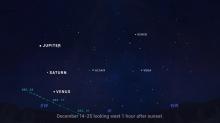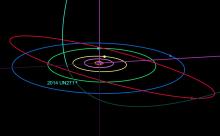Listen to today's episode of StarDate on the web the same day it airs in high-quality streaming audio without any extra ads or announcements. Choose a $8 one-month pass, or listen every day for a year for just $30.
You are here
Comets
Comets are studies in contrast. A comet can be both tiny and huge, dark yet bright, ancient yet new.
A comet started life as a ball of rock and ices left over from the birth of the solar system. It was hurled far from the Sun by the gravity of one of the giant planets. If it gets a nudge from another body — an impact with another iceball, for example, or a gravitational nudge from a passing star — it can fall toward the Sun.
The body of a comet is known as a nucleus, and it’s quite small — most are no more than a few miles in diameter. Its surface is coated with rock, dust, and organic compounds that make it darker than charcoal.
As it approaches the Sun, though, it undergoes a dramatic change. As it warms up, some of its ices vaporize. In turn, that releases grains of solid particles. The gas and dust form a glowing cloud around the nucleus, known as a coma. It can span tens of thousands of miles or more.
Sunlight and solar wind push some of this material away from the nucleus, sculpting a tail that can be millions of miles long.
And that’s when a comet becomes a comet. The name comes from an ancient Greek word that means “wearing long hair” — a reference to the tail. The coma and tail can be quite bright, allowing us to see a comet over a great distance.
And while its nucleus is ancient, a comet can be brand new. Many are making their first trip through the inner solar system — the first appearance of a comet.
More about comets tomorrow.
Script by Damond Benningfield






